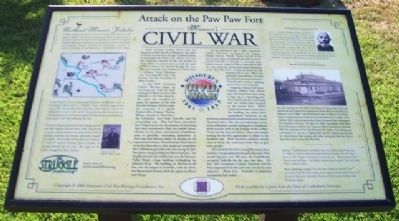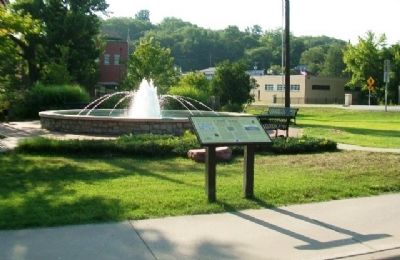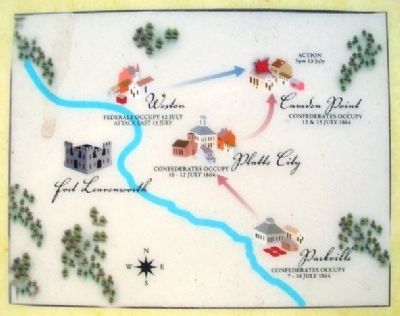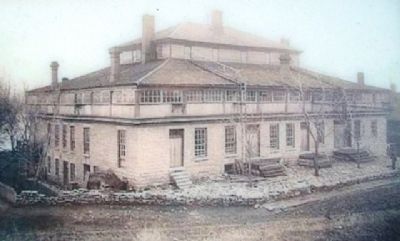Parkville in Platte County, Missouri — The American Midwest (Upper Plains)
Attack on the Paw Paw Fort
Missouri's Civil War 1861 - 1865
— The Struggle for Platte County —
Northwest Missouri Tinderbox
Conflict and uncertainty were widespread in northwest Missouri in the summer of 1864. Federal forces struggled in a heavy-handed manner to control areas much too large for their capabilities. Raiders from Kansas, including Red Legs (Union scouts with an earned nefarious reputation) and jayhawkers (troops notorious for marauding) continued to terrorize and pillage the local population. Confederate activity began to significantly increase as large guerrilla bands and recruiters such as Lieutenant Colonel John C. Calhoun "Coon" Thornton aggressively roamed the countryside reclaiming towns from Federal control and adding new recruits to their ranks. In part this increase in activity was a belated reaction to the brutal conduct of Federal forces and plunderers from Kansas who had infiltrated the area.
Northwest Missouri personified the bloody guerrilla war that raged in the area since 1856. No quarter was given and no quarter was asked as the bands of Missouri guerrillas and Kansas jayhawkers fought for control. This already volatile situation escalated as word of General Sterling Price's invasion of Missouri filtered into the area. The stage was set for the Struggle for Platte County.
Major General Sterling Price's raid into Missouri in 1864 was the Confederacy's last effort to liberate the state from the grip of Federal control. In preparation for Price's raid, officers were sent into numerous counties in the area known as "Little Dixie" to recruit men to swell the ranks of Price's army as he moved through the state. One such recruiter was Lieutenant Colonel John C. Calhoun "Coon" Thornton, who was originally from Clay County but was recruiting in Platte County.
In July 1864, Lieutenant Colonel Thornton began his recruiting and "hold the land" campaign in Platte County with Parkville as his first objective. The town was occupied by about 60 members of the 82d Enrolled Missouri Militia under the command of a regular Federal officer, Captain Thomas Wilson. Known as "Paw Paws", the militiamen were from Parkville and the surrounding area. They had been conscripted into Federal service for the purpose of protecting their local communities from any outside threat, whether it was from conventional Confederate units or guerrillas, marauding jayhawkers, or Red Legs from Kansas intent on preying on the unprotected civilians. The militiamen were referred to as Paw Paws due to their suspected sympathies for Confederate guerrillas who hid among the Paw Paw plants along the Missouri River bottoms. The headquarters for the militia unit was the Missouri Valley Hotel, a large building overlooking the Missouri River. The building, at 100 feet by 80 feet, was
the largest in Parkville, with the lower two floors made of stone while the upper two floors were frame.
On the morning of July 7, 1864, Lieutenant Colonel Thornton, accompanied by Captain Charles Fletcher "Fletch" Taylor and 60 of this partisan guerrillas, including Frank and Jesse James, entered Parkville to demand its surrender from Federal control. Captain Wilson immediately fled the town while his militia barricaded themselves in the "Paw Paw Fort". A shot was fired from the hotel but hit no one. When the guerrillas immediately returned fire militia Lieutenant Martin C. Noland and a woman standing next to him were wounded.
Angered at being fired upon, Captain Taylor's men forced open the locked front door using a large log as a battering ram. They entered the fort and found that the militia had retreated to the second floor. When Taylor threatened to burn down the building the militia force surrendered. Forty-two of the militiamen immediately joined Lieutenant Colonel Thornton's force. This was not surprising as many of the militiamen actually belonged to Confederate secret societies such as the Knights of the Golden Circle and the Sons of Liberty. They were simply waiting for the first opportunity to defect to the Southern side. With Southern uniforms already close at hand, the conversion from blue to gray went quickly.
Not all the Paw Paws joined
Thornton's force and they were paroled and released unharmed. Now numbering just over 100 men, the Confederates occupied Parkville for the next two days. On July 10th Lieutenant Colonel Thornton and his force departed Parkville and rode toward his next objective -- Platte City. Parkville's Confederate occupation had ended.
———————
John C. Calhoun Thornton, known as "Coon" to his troops, was born in Missouri in 1835. Prior to the Civil War he practiced law in Leavenworth, Kansas, and later St. Joseph, Missouri. He joined the Confederate army when the war broke out and was a battalion commander at the battle of Wilson's Creek in August 1861. As a result of his gallantry in that battle he was promoted to Lieutenant Colonel. He survived the war and moved his family to Butte, Montana where he practiced law before going into the mining business. He died in 1887, leaving a wife and eight children.
———————
You are standing on the site of the Missouri Valley Hotel that was used as the headquarters for the 82nd Enrolled Missouri Militia on July 7, 1864. Colonel George S. Park, a veteran of the Texas War For Independence and the town's namesake, built it in 1851. From 1853 to 1855 it also served as the office for Colonel Park's newspaper, The Industrial Luminary. On April 14, 1855, a proslavery
mob threw the printing press into the river because of Park's abolitionist editorials. With the outbreak of the War Between the States the building was confiscated for use as a headquarters by the Federal government for Union forces, both regular and militia, occupying Parkville. Thus it became known as the Paw Paw Fort.
———————
Sources: "'Bashi-Bazouks' and Rebels Too: Action at Camden Point, July 13, 1864" by Scott A. Porter, Missouri Historical Review, Vol. 101, No. 2, January 2007. "Intense Excitement in Parkville, Mo - The Luminary Press Thrown into the River - The Editors Driven from the town", The New York Times, April 26, 1855.
Photo and Image Credits: Paw Paw Fort: Fishburn Archives, Park University, Parkville, MO; Taylor: used with permission, State Historical Society of Missouri, Columbia; Thornton: Clay County Archives and Historical Library
Erected 2009 by Missouri's Civil War Heritage Foundation, Inc., and Sons of Confederate Veterans.
Topics and series. This historical marker is listed in this topic list: War, US Civil. In addition, it is included in the Jesse James, the Missouri’s Civil War, and the Sons of Confederate Veterans/United Confederate Veterans series lists. A significant historical date for this entry is January 2, 2007.
Location. Marker has been permanently removed. It was located near 39° 11.305′ N, 94° 40.909′ W. Marker was in Parkville, Missouri, in Platte County. Marker was on NW River Park Drive (Missouri Route 9) 0.1 miles east of East Street, on the right when traveling east. Touch for map. Marker was at or near this postal address: 8701 NW River Park Drive, Kansas City MO 64152, United States of America.
We have been informed that this sign or monument is no longer there and will not be replaced. This page is an archival view of what was.
Other nearby markers. At least 8 other markers are within 6 miles of this location, measured as the crow flies. Park Bank - Farmers Exchange Bank (about 500 feet away, measured in a direct line); Quindaro Ruins Archaeological Park (approx. 2.8 miles away in Kansas); Quindaro, Kansas (approx. 3 miles away in Kansas); John Brown (approx. 3 miles away in Kansas); Western University (approx. 3 miles away in Kansas); Renner Village Site (approx. 3.7 miles away); Mather Hall - Kansas City University (approx. 4.3 miles away in Kansas); Delaware & Wyandot Reserve (approx. 5.7 miles away in Kansas).
Also see . . .
1. Missouri's Civil War. Website homepage (Submitted on June 15, 2013, by William Fischer, Jr. of Scranton, Pennsylvania.)
2. About Parkville. City website entry (Submitted on June 15, 2013, by William Fischer, Jr. of Scranton, Pennsylvania.)
Additional commentary.
1. Marker removed.
Marker was removed last week because “complaints were received from citizens who felt some references on the markers were offensive.” Read the marker for yourself.
— Submitted June 21, 2020, by Mark Hilton of Montgomery, Alabama.
Credits. This page was last revised on October 5, 2022. It was originally submitted on June 15, 2013, by William Fischer, Jr. of Scranton, Pennsylvania. This page has been viewed 1,217 times since then and 46 times this year. Photos: 1, 2, 3, 4. submitted on June 15, 2013, by William Fischer, Jr. of Scranton, Pennsylvania.



